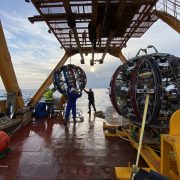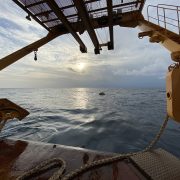ORCA6 completed
With the installation of two more detection units at the French site of KM3NeT, the first phase of building the ORCA detector is completed! Since 27 January 2020, the detector is taking data with six detection units.
During a sea operation the 24-26 January 2020, the two new detection units have been connected to the KM3NeT/ORCA seafloor network at the KM3NeT/ORCA deep sea site, 40 km offshore from Toulon, France. The detection units were successfully positioned twenty metres apart.to within a metre of their target position 2.5 km below the sea surface. This highlights the skills of the staff on board the deployment ship, the precision of the custom acoustic positioning system and the maturity of the deployment method based on an innovative launching vehicle.
Immediate data taking
Using a robot, remotely operated from a second ship, the deployed units were connected to the seafloor network of the ORCA site. After a visual inspection of the detection units by the robot, the power was switched on and data taking with ORCA6 started immediately.
The ORCA detector has now six detection units – hence ORCA6. These are six vertical lines each with 18 sensor modules. A module houses 31 light sensors (photo-multiplier tubes) to record the faint Cherenkov light generated by charged particles in the sea water. That makes now 6x18x31= 3348 photo-multipliers in total in ORCA6. Each photo-multiplier records the intensity of the light flash and when it arrives. A compass, tilt meter and acoustic receiver record the position of the module in the sea water. With these measurements the path the charged particle took through the detector is precisely reconstructed.
The video below shows a selection of down-going cosmic rays (muons) passing through the ORCA6 detector soon after power up.
Important
Operating six detection units is an important milestone for KM3NeT as it marks the completion of the so-called ‘Phase 1’ of the project. In the next phase of KM3NeT/ORCA, the detector will be extended to 115 detection units.
Photo gallery






